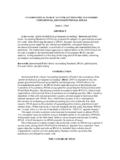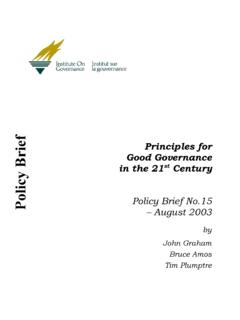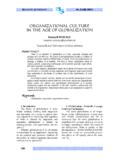Transcription of EMERGING TRENDS IN GLOBAL MOBILITY: Talent …
1 TalentManagement2009 EMERGING TRENDS INGLOBAL MOBILITY: Cartus 2009 EMERGING TRENDS in GLOBAL mobility : Talent management 2 Introduction and Objectives International assignments serve many purposes for multinational corporations . At the tactical level, they facilitate GLOBAL business by allocating human capital effectively putting the right person in the right job. Today, companies are paying increased attention to international assignments as a strategic tool for developing employees with promise. The benefits to the organization and the employee may be secondary and delayed, but they are nevertheless universally acknowledged. In the real world, there is often a contrast between (1) a company s intent to use relocation as a tool to support the development of their human resources and (2) concrete verifiable plans to advance this goal.
2 All said, the links between Talent management and mobility are not confined to developmental assignments. There is also a shift in organizations as they begin to focus strategically on what happens to employees with international experience during and after an assignment, with particular emphasis on maximizing the return on investment. The purpose of this survey, then, is to investigate the ways companies say they use mobility to further their Talent management goals, with special attention to both best practices and pitfalls. To approach this task, we focused on three points in time before, during, and after the employee s international assignment to help assess the degree to which Talent management planning actually found its way into the process and, ultimately, how successfully companies achieved employee development goals as a result of the assignment.
3 The survey was conducted in August 2008 and attracted responses from 56 companies, including many of the world s largest and most thoroughly GLOBAL organizations. Cartus 2009 EMERGING TRENDS in GLOBAL mobility : Talent management 3 Phase 1. Selection and Preparation To understand how companies use mobility strategically, we first need to know how they determine which employees will be sent on international assignment. Respondents were asked to identify the top two criteria for selecting employees for international assignments (see Chart 1). The strong majority of companies chose technical competencies (72%) and job experience (65%) over the next highest rated reason, willingness to accept the assignment (24%), showing a decidedly tactical decision-making rationale. Only 9% of respondents mentioned developing Talent as one of the two top selection criteria.
4 CHART 1. Criteria for Assignment Selection (Top 2) This pragmatic focus on deployment does not necessarily conflict with a broader focus on Talent management ; each has its own distinct priorities. Deployment encompasses such issues as: > Opening new offices or markets; > Transfer of skill or knowledge; > Filling a Talent gap; and > Allocating an employee with experience in the local culture. On close examination, all of these relate more closely to the receiving parties or office location than to the assignee. On the other hand, a strategic focus emphasizes: > Career development; > GLOBAL work force development; > Leadership development; and > Succession planning. All of these are issues with the assignee s professional growth and the company s leadership development at their roots. 0%10%20%30%40%50%60%70%80%Technicalcompe tenciesJo bexperienceWillingness to acceptthe assignmentCultu raladaptability traitsOtherDon t knowTechnical issues of task performance trumped Talent development as assignment selection criteria.
5 Cartus 2009 EMERGING TRENDS in GLOBAL mobility : Talent management 40%10%20%30%40%50%Agree stronglyAgree somewhatNeither agree/disagreeDisagree somewhatDisagree stronglyFrequencyRegardless of the motivation for the assignment, the assignee s suitability to perform effectively plays a key role. As Chart 2 illustrates, companies consider current and past assignees to be best prepared in general business issues, and least prepared in issues specific to the new location. Prior research by Cartus indicates that these local issues are most highly associated with assignment difficulties and failure, thus indirectly posing a serious obstacle to any goals, tacit or explicit, of developing the CHART 2. Degrees of Assignee Preparedness* Best Prepared Least Prepared Skills/technical capabilities 83 % 2 % Knowledge of assignment objectives 54 9 General international business capabilities 33 28 Knowledge of host country business environment 13 56 Ability of family to adapt 7 44 Knowledge of host country culture 7 58 Don t know 6 9 * Multiple responses possible.
6 Nearly two-thirds of respondents agree that cultural adaptability traits enter into the selection of employees for international assignments (see Chart 3). And yet they consider assignees least prepared in this general area (refer to Chart 2). One could argue that these assignees could be culturally adaptive without having knowledge of the host country and business environment, but it is doubtful that companies would make such a fine distinction. It is more likely that the lack of preparation for employees about to go on assignment results from the fact that they are not offered, or do not avail themselves of, the training that would increase their effectiveness in this key area. CHART 3. Agree/Disagree: Cultural adaptability traits enter into the selection of employees for international assignments. 1 See Cartus 2007 EMERGING TRENDS in GLOBAL mobility , Policy & Practices Survey, available on request.
7 Although local awareness ranked low as a way in which employees are prepared for assignments, it generally ranks high in contributing to assignment failure. Cartus 2009 EMERGING TRENDS in GLOBAL mobility : Talent management 50%10%20%30%40%50%Agree stronglyAgree somewhatNeither agree/disagreeDisagree somewhatDisagree stronglyFrequencyIn this vein, two out of three companies report that they offer formal training in two other important areas: intercultural (69%) and language (63%). Only 20% offer business briefings, however, even though knowledge of host country business environment (at 56%) ranked just behind knowledge of host country culture (58%) as the area where they considered assignees least prepared. In Cartus experience, we find that selection is most often conducted by the business unit in need of an assignment and with very little advanced notice or coordination with L&D or the GLOBAL mobility team.
8 If the majority of companies are using technical skills and job experience as their primary selection criteria, then Cartus recommends supporting the employee s training in the areas of knowledge of host country business and culture through coaching, online tools, and/or traditional training programs as a logical post-selection strategy, if not requirement. In doing so, the company adjusts to the reality of a less defined selection process and creates a strategy of assignee support via preparation post-selection instead of pre-selection criteria or support during selection. Phase 2. On-Assignment Communication It goes without saying that employees enter international assignments with clearly stated goals; only 15% of respondents disagreed with this premise (see Chart 4). Likewise, 85% of respondents agreed that assignees have annual performance evaluations completed while on assignment.
9 CHART 4. Agree/Disagree: Clear performance objectives are formally established, articulated, and communicated to assignees prior to the assignment. Responses to two other questions cast doubt on how effectively companies believe assignees are monitored or managed, however. A full 35% of respondents disagreed with the statement: home location managers know how successfully assignees are adjusting and performing. Similarly, 35% disagreed with the statement that assignees meet frequently with their managers or HR to discuss assignment objectives, goals, and career planning. Nearly one-third of these (10% of total respondents) disagree strongly with this statement. Cultural adaptability as a trait influences assignment selection but tends not to be supported by practical training in host country issues.
10 Cartus 2009 EMERGING TRENDS in GLOBAL mobility : Talent management 6 Companies were then asked about their expectations for contact with employees on assignment (see Chart 5). While 13% said that guidelines for interactions with home managers are in place, not one company reported a formal requirement. The general conclusion one can draw is that, from a strategic point of view, the employee enters a less structured environment, perhaps out of necessity, once the assignment starts, with predictable implications on the company s ability to leverage the employee s experience to it own benefit. A strategic Talent management approach to addressing this finding one offering a quick win would be to establish communication requirements and tools to support those requirements. These should include guidelines that define roles and responsibilities for assignees and home country managers, sponsors, or HR, providing support instead of a dependence on luck.









